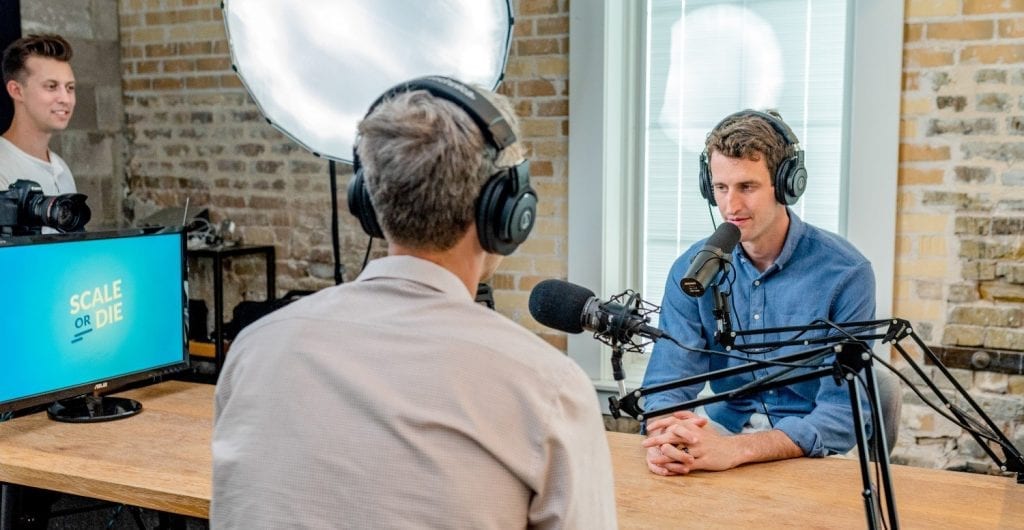Wondering what is brand journalism, why it matters and how to use it in your organization?
In this guide, we cover these questions and more.
Here’s what we’re covering:
- What brand journalism is
- Why it matters for CMOs
- 5 examples of great brand journalism
Let’s get right into it.
Link building cheat sheet
What is Brand Journalism?
You may be familiar with brand journalism by a different name such as corporate journalism or corporate media but however you refer to it, the real importance is understanding how it can benefit your business.
Answering what is brand journalism is complex and not all companies would provide the same answer.
Most would agree though that the art of storytelling and content creation is essential to forming relationships with your audience and providing information to help them make decisions that impact their daily life.
The importance of brand journalism doesn’t lie in the form of communication but in the story behind it.
Also, you need to understand that brand journalists aren’t necessarily PR people as brand journalism exists in the intersection of PR, content marketing and storytelling.
And, telling a good story isn’t always about marketing.
Brand journalism goes beyond traditional marketing strategies to provide a more complete story of the company.
One great example of this is Adobe.
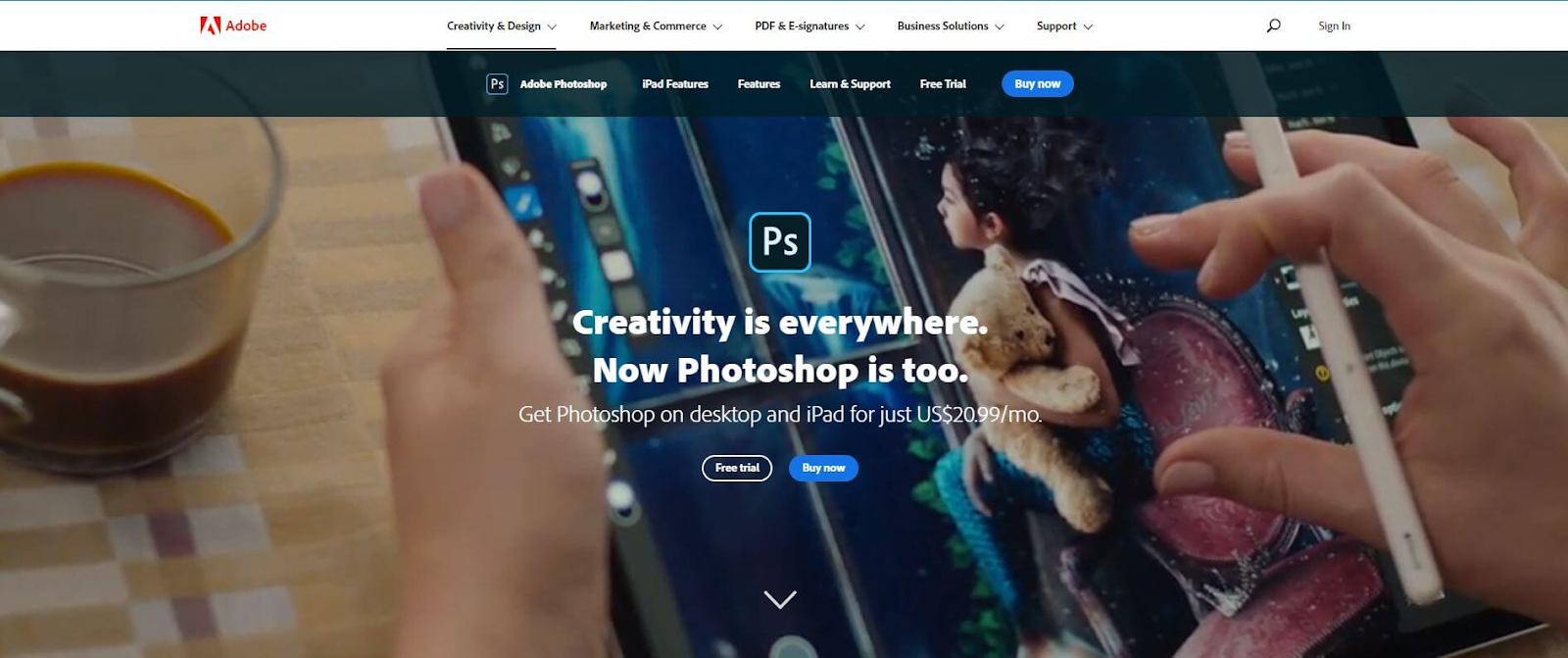
On each product page they have an explainer video showcasing the product and several users working with them in different ways that bring you into their digital world.
Videos are great because they easily allow you to share your product and tell a story at the same time.
They are also very engaging so it draws the consumer into your brand.
Most importantly though, Adobe is trying to tell a story.
It presents the brand as something more than just a simple software and makes people want to participate and be a part of this story.
Another great example of brand journalism is Warby Parker.
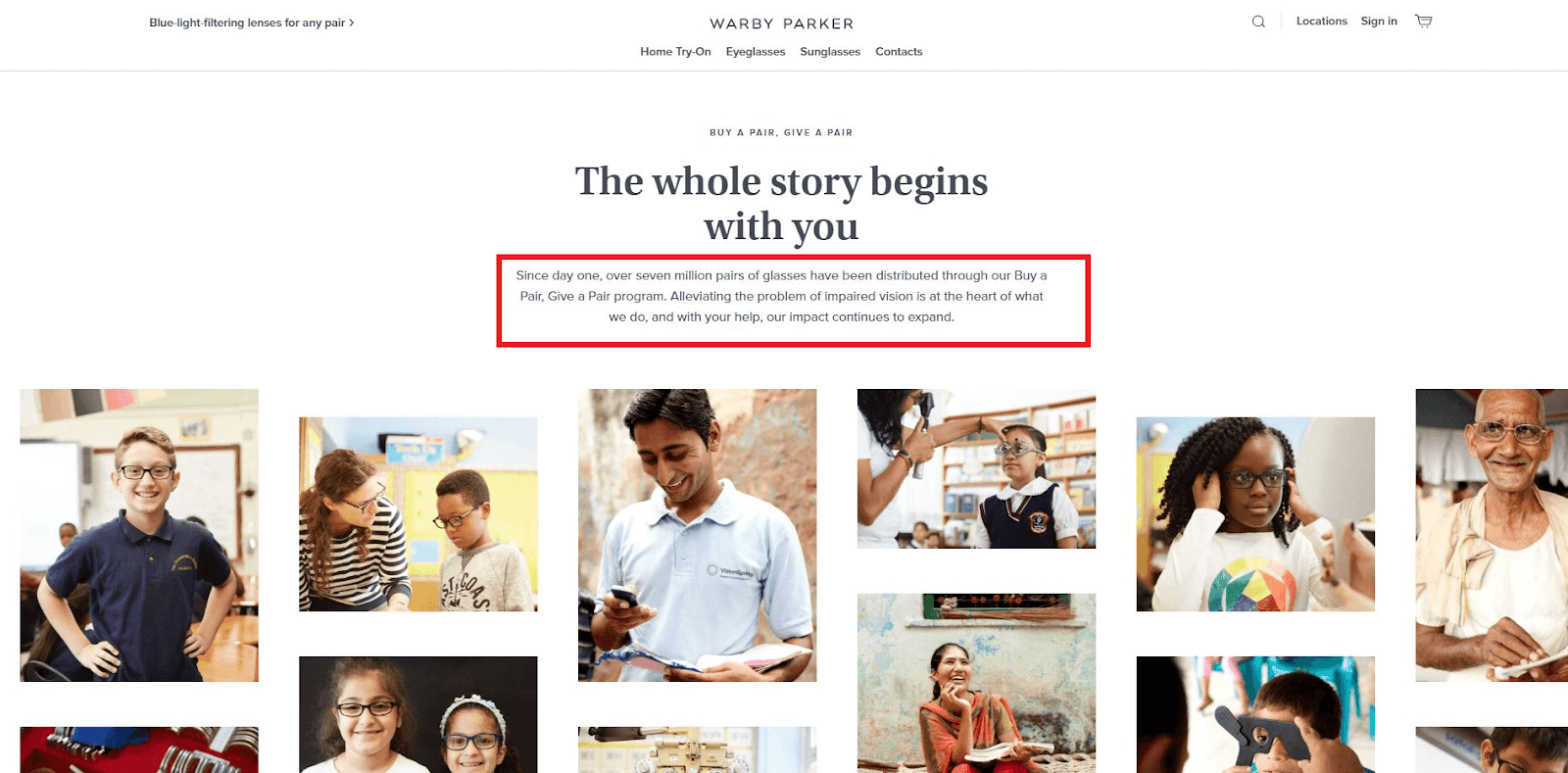
Warby Parker does a great job of telling the story behind their glasses through the educational resource “How Our Glasses Are Made”, which showcases photos and videos throughout the entire production process, and their “Buy a Pair, Give a Pair” program, which gives a pair of glasses to a person in need for every pair sold.
Both of these pages tell a unique story about Warby Parker while creating a deeper relationship with their audience.
The “Buy a Pair, Give a Pair” page also does a great job by highlighting how many pairs of glasses they’ve given away since the company was founded and then going on to tell more about how it works.
Instead of listing bullet points or writing long copy on what a brand can do for the customer, brand journalism opens the avenue to have an actual conversation, leading brands to better connect with their target audience.
After all, according to the following definition by Brand Journalists, “brand journalism involves telling journalism-style stories about a company that make readers want to know more….”

Brand journalism also differs from traditional journalism and the way traditional media outlets communicate their messages.
That’s because the focus is not only pushing the information out but establishing a relationship with your audience as well.
Brand journalism allows you to get your message across in a way a customer can relate to.
The term was originally coined in 2004 by McDonald’s Chief Marketing Officer (Larry Light), after realizing mass marketing no longer worked and seeing the need for brands to create a full story about what happens to a brand in the world.
Rejecting traditional marketing, Light focused on brand positioning through a journalistic-style of writing about many different topics, aimed at a variety of brand interests.
That is when the term “Brand Journalism” was born.
Why Brand Journalism Matters for CMOs
Now that you are more familiar with brand journalism (if you weren’t before), let’s take a look at why brand journalism matters, especially for CMOs.
As CMO, you are in charge of brand management, marketing communications, market research, product marketing and more. Brand journalism can help you achieve your goals in all of these areas.
Here are a few important things to note about brand journalism:
- As the media and marketing tactics converge, more brands are launching publishing options so you have to make your content stand out
- Storytelling is a powerful way to connect with your audience
- You can build the trust customers have for your brand through credible and honest published material
From those points, you can see the need to make your brand’s story known is as important as the human desire for meaningful connections. That is why brand journalism is so important because it brings both of those things together.
With 69% of Gen-Z seeing ads as disruptive and 61% who are willing to pay more for products that are produced ethically and sustainably, brand journalism is important to the next generation of buyers whether they realize it or not.
The more engaging content you can produce, the more effective your lead-generation will be, ultimately driving more sales.
Dave Gerhardt is a CMO leading by example!
Dave knows the importance of CMOs sharing their brands story because he first grew Drift into a SaaS with over 50 thousands users worldwide and is now doing the same with Privy.

Dave also goes beyond Drift’s platforms to share industry tips, news and trends.
He does a great job of telling stories through his LinkedIn posts but also engages his audience through open-ended questions, polls and more.
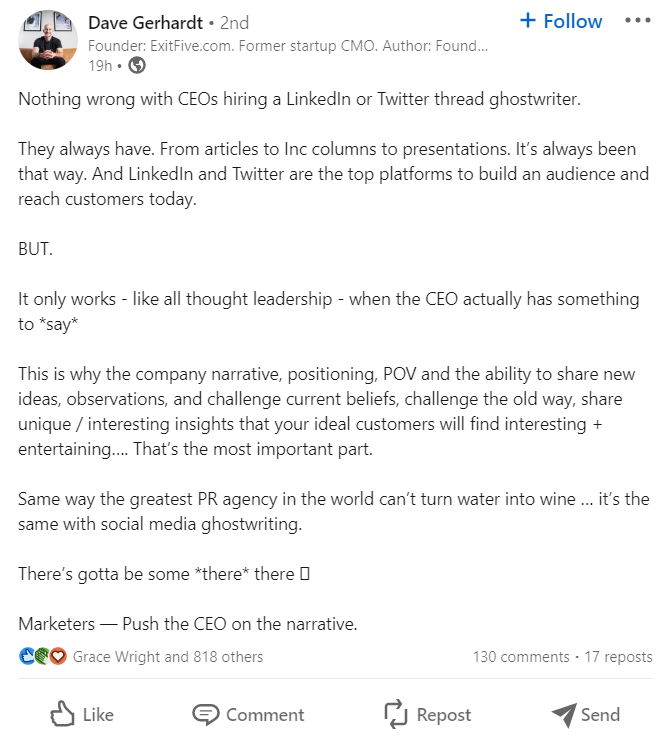
Author’s Note: We will take a closer look at Drift in our next section.
Both with Drift and with Privy, Dave tries to promote the company’s news, successes and struggles telling journalism-style stories.
This allows him to connect on a deeper level with his audience, and ultimately promote the products of these two companies.
Over the past few years, many companies have started to adopt the same approach, as a way to connect with their audience and reach new audiences.
Is Brand Journalism The Same As “Regular” Journalism?
No, brand journalism is not the same as regular journalism.
Brand journalism is a type of content marketing in which a media company or brand produces compelling content in the style of a news outlet (like New York Times, for example), typically to promote its own products, services, or interests.
It is a type of corporate communication that is designed to increase brand loyalty and awareness and engagement and to promote the brand’s values and identity.
Regular journalism, on the other hand, is the practice of gathering, reporting, and analyzing news and information.
It involves researching, verifying, and presenting news stories in a thorough and accurate manner, often with a focus on impartiality and the public interest.
The difference between brand journalism and regular journalism is that brand journalism is created and disseminated by the company or brand itself, while regular journalism is created by independent journalists and reporters.
While both types of journalism involve reporting and analyzing news stories, regular journalism is focused on providing impartial, unbiased coverage, while brand journalism is focused on promoting the brand’s values and identity.
Additionally, regular journalism is often subject to ethical and legal standards, while brand journalism is not typically subject to the same constraints.
Ultimately, brand journalism is a form of custom content marketing, while regular journalism is a form of reporting and analysis.
They both have their place in today’s mainstream media landscape, but they serve different purposes and should not be confused.
Brand Journalism Vs Content Marketing
Brand journalism is really just a subset of content marketing.
Content marketing is an umbrella term for a variety of marketing techniques aimed at creating and distributing content to attract and engage potential customers.
Brand journalism, which involves creating content with the goal of establishing a brand’s image and reputation, is one of these techniques.
The goal of brand journalism is to provide readers with entertaining and informative stories about the brand that are not overtly promotional.
This type of content can help to establish the brand’s credibility and build trust among readers.
It can also be used to show the human side of a brand, providing readers with an insight into the people behind the brand and how it operates.
By providing stories that are interesting and engaging, brand journalism can be a powerful tool for content marketing.
Brand journalism can be thought of as content marketing with a focus on storytelling.
It is an effective way to create engaging content that can help to build a brand’s image and reputation.
By creating content with a storytelling focus, brands can create an emotional connection with their readers and engage them in a way that traditional advertising cannot.
Do You Need A Brand Journalism Team?
The short answer is, it depends. A brand journalism team can be incredibly beneficial in helping to create and distribute content that is both engaging and effective in communicating your brand’s message.
However, it’s important to consider whether your team has the resources and expertise necessary to make this type of content successful.
If you have a dedicated marketing or communications team in place, then it may be possible to enlist their help in creating content for your brand.
If this team is well-versed in journalism or has a deep understanding of storytelling, then it may be worth creating a brand journalism team.
On the other hand, if you don’t have the resources or expertise necessary to create effective content, then it may be worth hiring a brand journalism team to help create content that is engaging, on-brand, and resonates with your target audience.
A brand journalism team can help create content that is both informative and entertaining, and can help you reach a wider audience.
In the end, the decision of whether or not to create a brand journalism team is one that needs to be made on a case-by-case basis.
Consider the resources and expertise that you have available, as well as the goals that you have in mind for your brand journalism efforts, before making a decision.
You can certainly go at it alone if you’re confident enough in your own journalism skills.
But if you are thinking of getting some help, here’s a breakdown of the ideal brand journalism team.
- Editor
The editor is the leader of the team and is responsible for ensuring that all content is of the highest quality and meets the standards set by the brand.
The editor is also responsible for overseeing the workflow of the team and ensuring that the content is delivered in a timely manner.
- Writers
Writers are essential in any brand journalism team, as they are responsible for creating the actual content.
Depending on the size of the team and the type of content being created, there may be multiple writers.
- Graphic Designers
Graphic designers are important for creating visuals that support the content being produced.
They should be knowledgeable in the brand’s visual style and have the ability to create visuals that are in line with the brand’s aesthetic.
- Social Media Manager
The social media manager is responsible for promoting the content and engaging with fans and followers on the various social media platforms.
They should be know their way around various social media platforms, understand how to best utilize them, and be able to monitor and respond to comments in a timely manner.
- Video Editor
If you plan on doing videos, an in-house editor may be necessary to help create them.
They should have experience editing videos and be adept at creating engaging visuals that capture the attention of viewers.
- Community Manager
The community manager’s job is to interact with your community, respond to inquiries, and help to direct customers to the appropriate resources.
They should have a good understanding of the brand and, of course, be able to effectively communicate with customers.
How To Develop a Brand Journalism Strategy?
Developing a brand journalism strategy is an in-depth topic that deserves a guide of its own.
So, in this section, we’ll only briefly walk through the most important steps in this process.
- What is your audience like?
Your audience can vary depending on your business and the objectives of your brand journalism strategy.
You should consider who your target audience is and what their interests and needs are.
You should also consider where they get their information from and what content they already consume.
This will help you shape the stories you tell, the content you produce, and the voice you use.
- What kinds of stories will you tell?
Your stories should be focused around topics that are of interest to your audience.
You should consider the topics that your audience is engaged with and the types of content they are already consuming.
This could include stories that showcase your brand, stories that educate your audience on topics relevant to your industry, stories that provide helpful advice, or stories that are entertaining.
We’ll take a look at some examples of the kinds of stories you may opt into telling.
- Who will be making the content?
We already walked through the ideal brand journalism team. If you don’t have the exact team composition available, delegating tasks and deciding who’s doing what is a big part of working out a smooth brand journalism strategy.
- What is your voice supposed to be?
Your content should have a consistent voice and tone that reflects your brand.
You should consider the values of your organization and the characteristics of your target audience when deciding on a voice.
It should be engaging, informative, and consistent.
Or crazy, if that’s your thing.
- What will be your publishing schedule?
A publishing schedule helps with two things: consistency, and ensuring content is delivered to users when they’re most active.
- How will you distribute content?
This refers to both platforms you’ll use, and the exact distribution strategies.
This could include using social media, email newsletters, blog posts, and other online platforms.
- How will you measure results?
You should set measurable goals that are in line with your objectives.
Traffic, conversions, social engagement are all good metrics to track.
You should also track the performance of each piece of content to identify what is working and what isn’t.
This will help you refine your brand strategy and ensure your content is having the desired impact.
5 Examples of Great Brand Journalism
The first example comes from Drift—a company that up until recently had Dave Gerhardt as its CMO.
Example #1: Drift
Drift is a Boston based technology company that specializes in conversational marketing and sales tools.
They have mastered content marketing, storytelling and media relations building through books, events, case studies and transparency.
Besides the main products tab, the website also has a tab highlighting all of these resources.

Under the main blog—which is full of valuable insights from thought leaders—there is a books section filled with reading options on conversational marketing and more.
This is great because they aren’t solely focusing on selling, they are also providing resources for lifelong learning.
Drift also hosts webinars about conversational marketing but their HYPERGROWTH event is the main attraction.
Several brand executives and high-achievers from all sorts of backgrounds come together each year to share success stories in their industry.
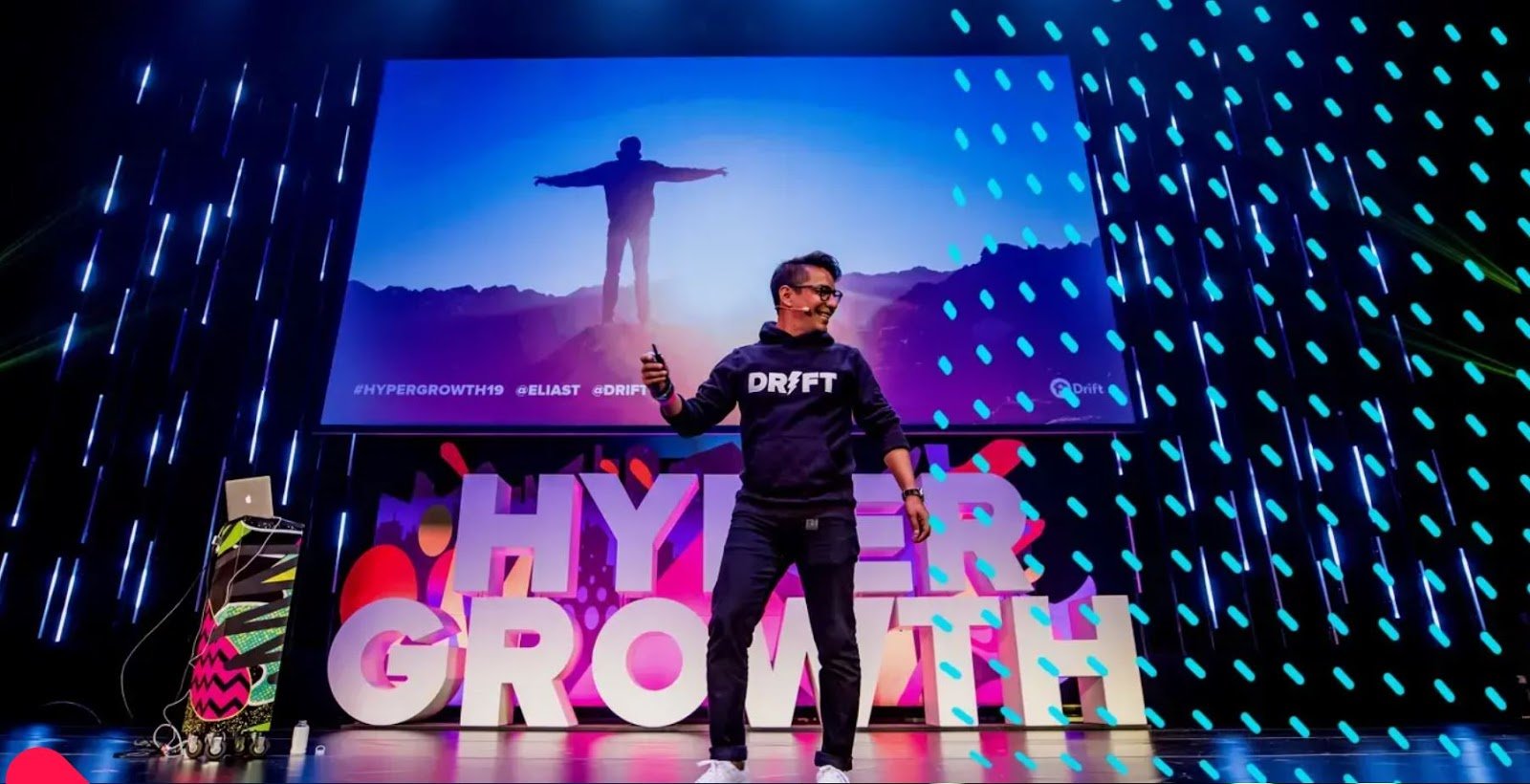
This allows Drift to create brand awareness while delivering thought-provoking content.
In fact, Drift has set out to create a conference unlike any other – essentially, their consumers create their own branded content for Drift—sharing photos, videos, and their experience at the event.
Drift also provides real-world examples throughout the year with case studies and success stories.
This is a great way for them to share stories with their target audience so they can see how Drift partners with their customers to build the future of sales and marketing.
One of the things we love most about Drift is how they showcase the head of customer relations right on the homepage! What other brand does that?
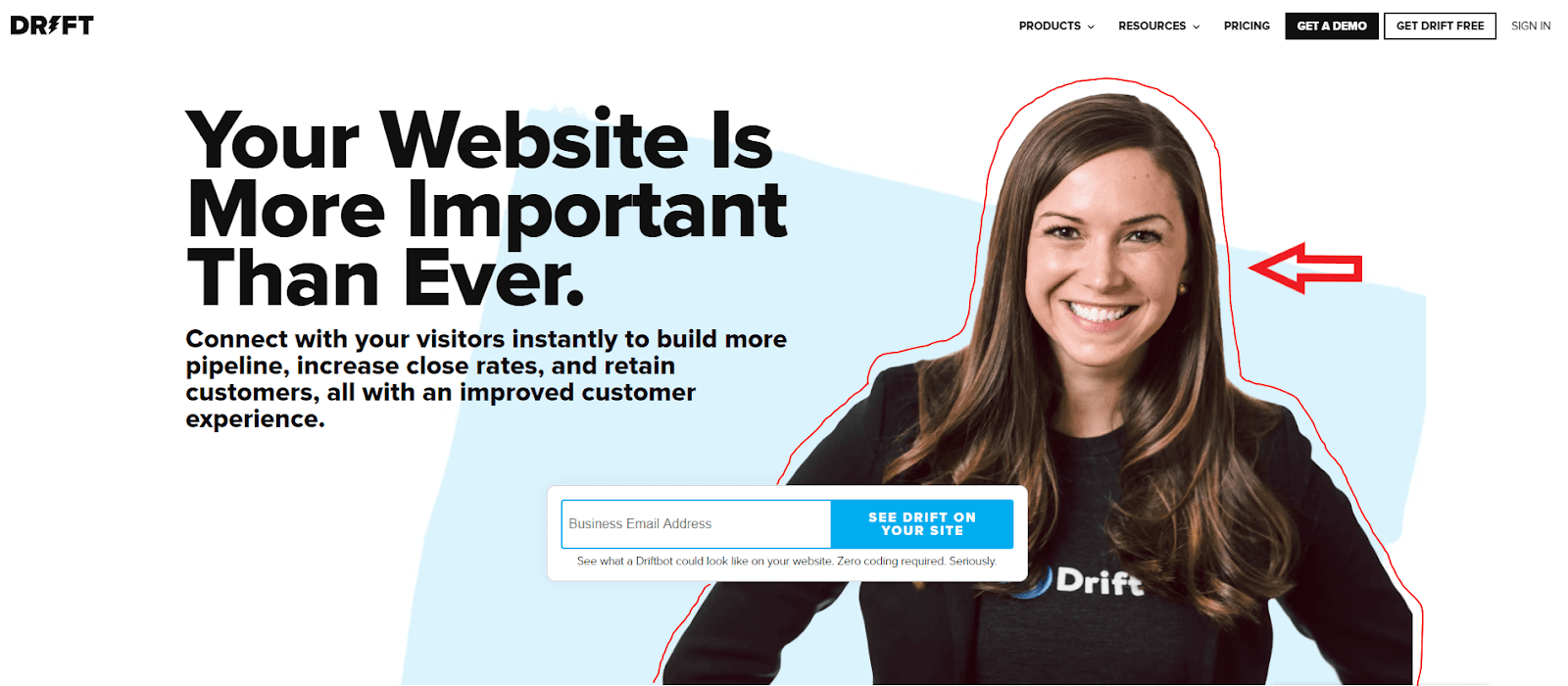
Brand journalism doesn’t have to be huge social media campaigns or long press releases, Drift is telling a story with a simple image and its placement.
They are showing their audience they care about them by highlighting the customer experience over the product and they are being transparent about who you will be speaking with if an issue does arise.
We’ve already mentioned the next generation of consumers values a brand they can trust in so transparency should definitely be a part of your brand journalism and content strategy.
Let’s move on to the next one.
Example #2: Intercom
Next, we have Intercom—a messaging platform that allows businesses to communicate with existing and prospective customers all within their app.
Some of the features that greatly benefit the customer experience are customizable bots, automated answers, targeted messages, and live chat options.
They are utilizing brand journalism through useful information on their blog, Inside Intercom.
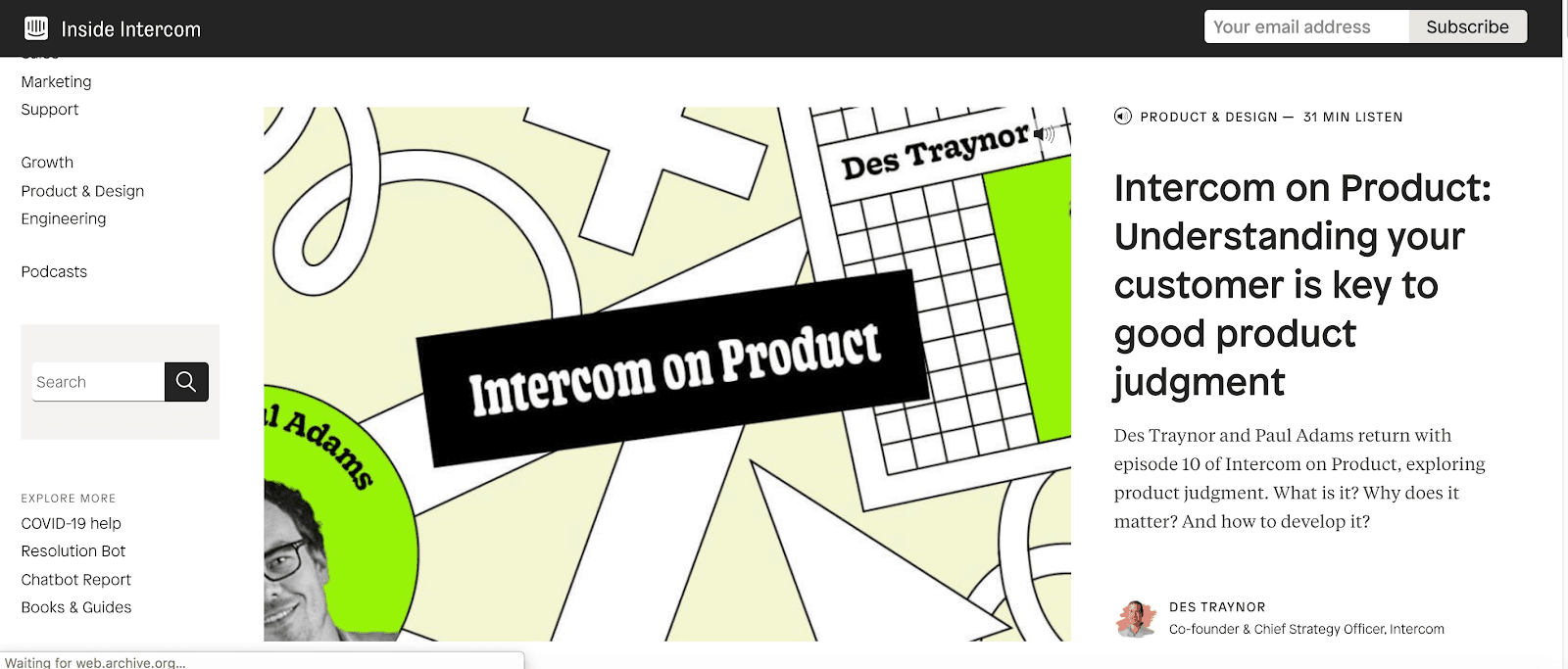
This blog provides weekly updates through written articles and podcasts that share knowledge, tips and lessons learned from years of product building experience.
There are several things we like about how they are presenting their own content. First is the speaker icon to easily identify the podcasts from the blog.
Second, the amount of time it will take to read or listen to the content is clearly displayed.
The last thing is how each author has a photo and their position at the company listed next to their name.
This openness will go a long way with your audience.
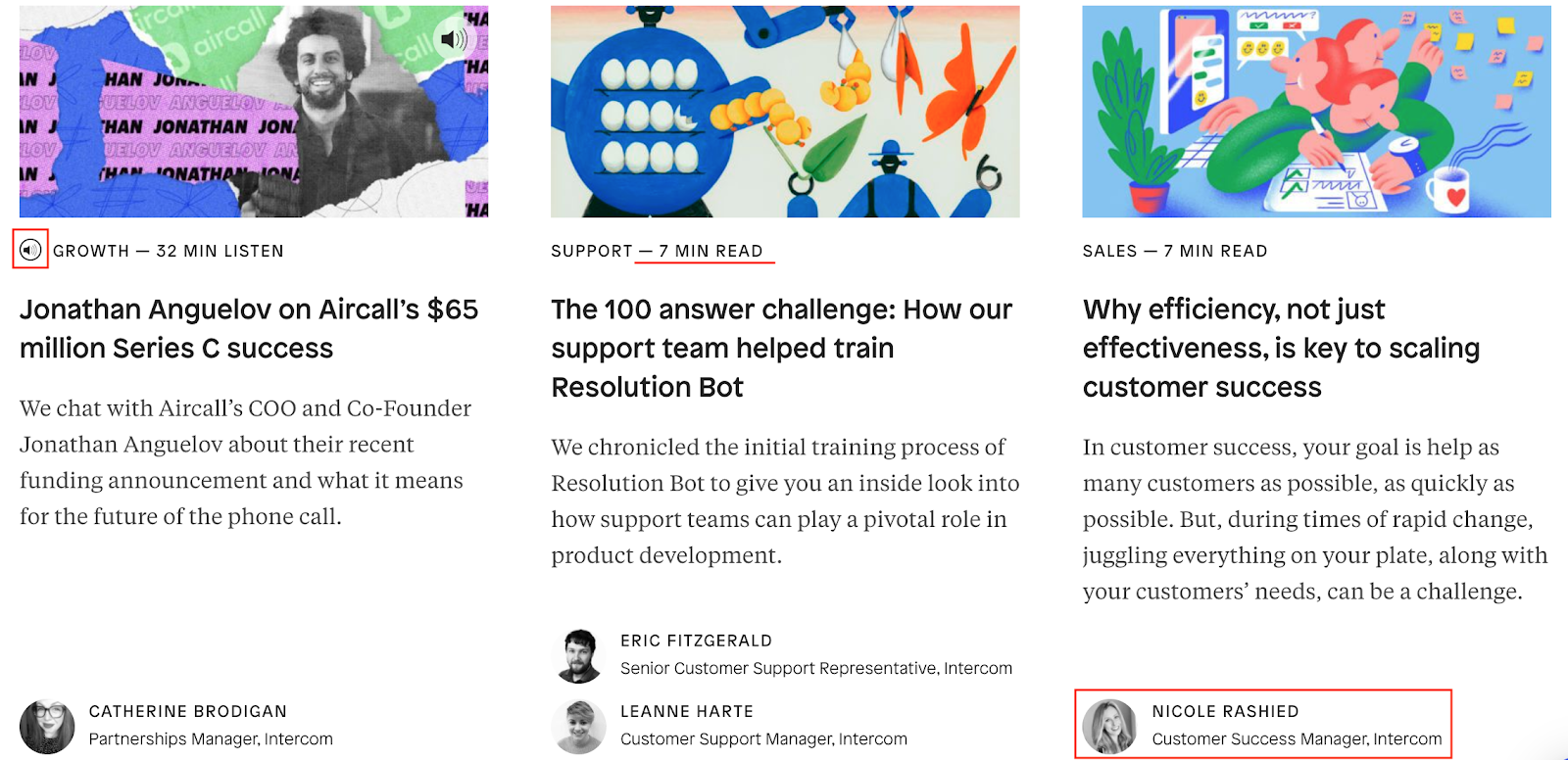
These are simple, yet impactful details that customers really appreciate because it shows that the company respects their time, helps put a face to the brand name and it makes a more personal connection with their readers.
Brand Journalism isn’t all about the design and trying to make things look pretty.
Content design can evoke a certain thought or feeling out of a customer or help determine the story you are creating for your business.
Intercom does a great job at this by providing articles that ultimately have the customer interest at the center of the conversation.
They really try to express their care for the customer through some of their timely blogs relating to prioritizing customer impact during COVID-19 or a podcast about customers being key for product judgment.
Example #3: Ahrefs
Our third example is Ahrefs—the popular SEO tool & resource for businesses looking to grow their search traffic.
Although they have a dedicated blog page on their website, their CMO, Tim Soulo, expands Ahrefs brand journalism tactics by hosting information on Medium, a well-liked site for bloggers, as well.
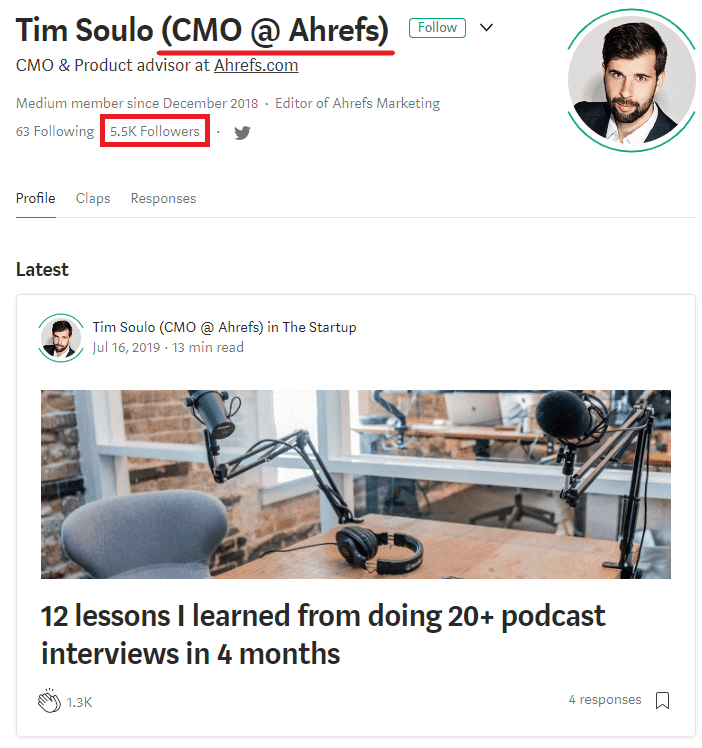
This is a great brand journalism tactic because Tim is providing valuable advice and insights on his experience while connecting a person to the brand.
This helps his audience (potential Ahrefs users) create a human connection with your brand.
Tim also has a great strategy going on, on his personal social media accounts (specifically Twitter).
His tweets share information about the company such as updates made to the website and his most recent pinned tweet—at the time of publication—gives you a virtual tour of the Singapore office.
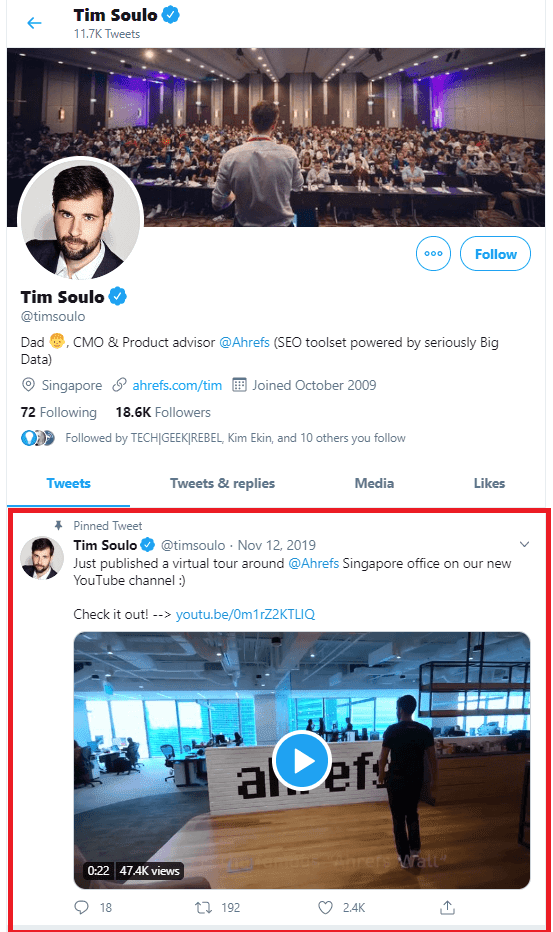
All of this goes a long way in the customer’s mind because they can see you are offering an inside look at your business and operations which gives them a sense of trust.
Building these avenues of trust is important for initial sales and establishing life-long customers.
The Ahrefs blog and Tim’s Medium blog offer knowledge on content marketing, lessons learned through failed campaigns and general SEO advice.
The main thing we would like you to take into consideration is that your media platforms should be a space for thought leadership and relationship building to come together to drive your business forward.
Ahrefs also has an outstanding SaaS Marketing Vlog on YouTube branded Ahrefs TV. Here you can find actionable SEO tutorials that help organizations increase their organic traffic and rank #1 on Google.
Again, this is providing valuable information to their customers while showcasing employees within the company and highlighting their knowledge.
Example #4: Basecamp
Now let’s look at Basecamp.
Basecamp is a project management app that provides the tools for either a company or individual freelancer to succeed with working remotely at home.
They offer tools where you can set up to-dos, a schedule, create and upload documents and files, message and chat with your colleagues.
As of 2020, they currently have 3.3 million (and counting) accounts signed up that trust the product they’ve been delivering for the past couple of years.
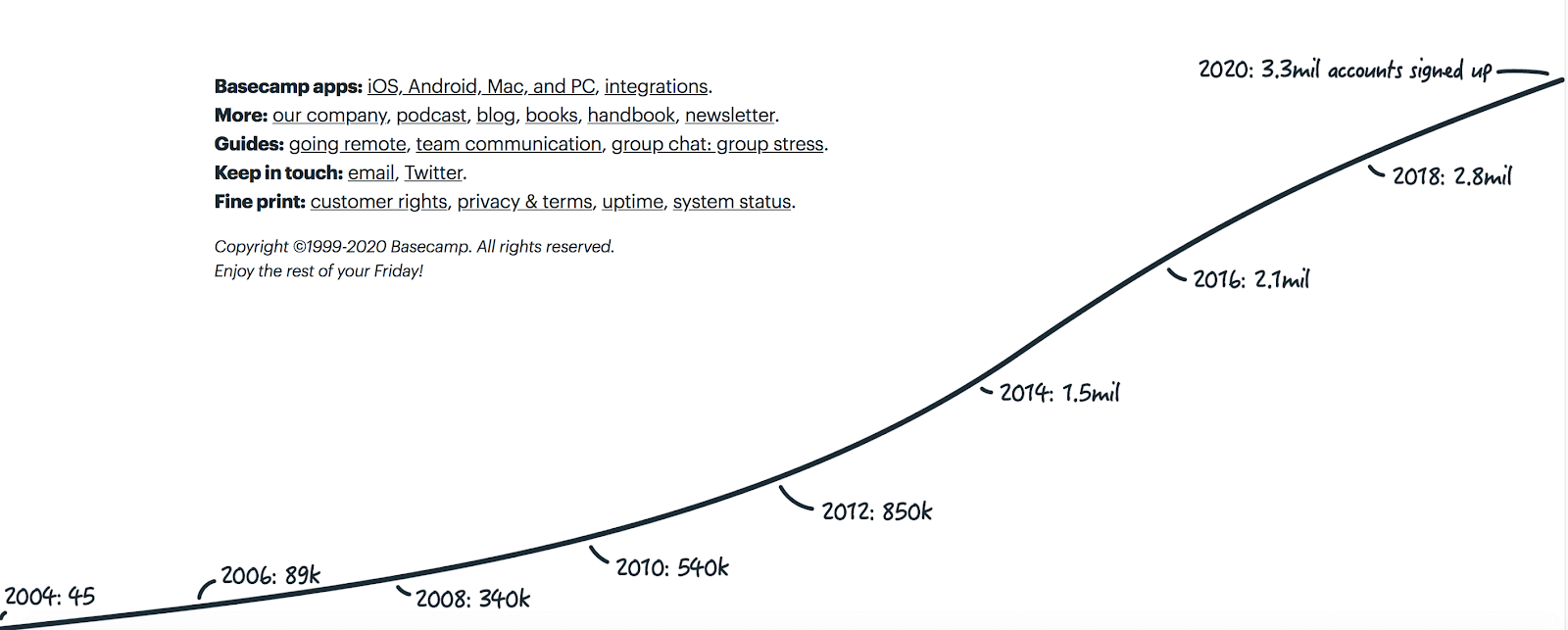
Placing this chart on the homepage of the website is great brand journalism because this is primarily where the customer journey for your audience begins and through a simple image they are sharing their own journey with you from the beginning.
Your potential customers feel valued when you share information you don’t necessarily have to and you allow them to be part of your journey with you.
It’s also nice for existing customers to see where you were on your journey when they signed up and where you are now. So much is said from this one graph.
On Basecamp’s website, you will see that there’s an abundance of additional resources, and one of those are the books written by staff members that provide relevant and practical advice.
For example, let’s take a look at the following one:
Remote: Office Note Required was written by Jason Friend and David Heinemeier Hansson, the founders of the company.
In this book, they share their profound advice on how to succeed in the virtual workforce and how to unleash unprecedented creativity and productivity working from home.
Diving deeper into the catalog of previous books you will see topics covered such as breaking free of “best practices”, work/life balance, and best practices for entrepreneurs.
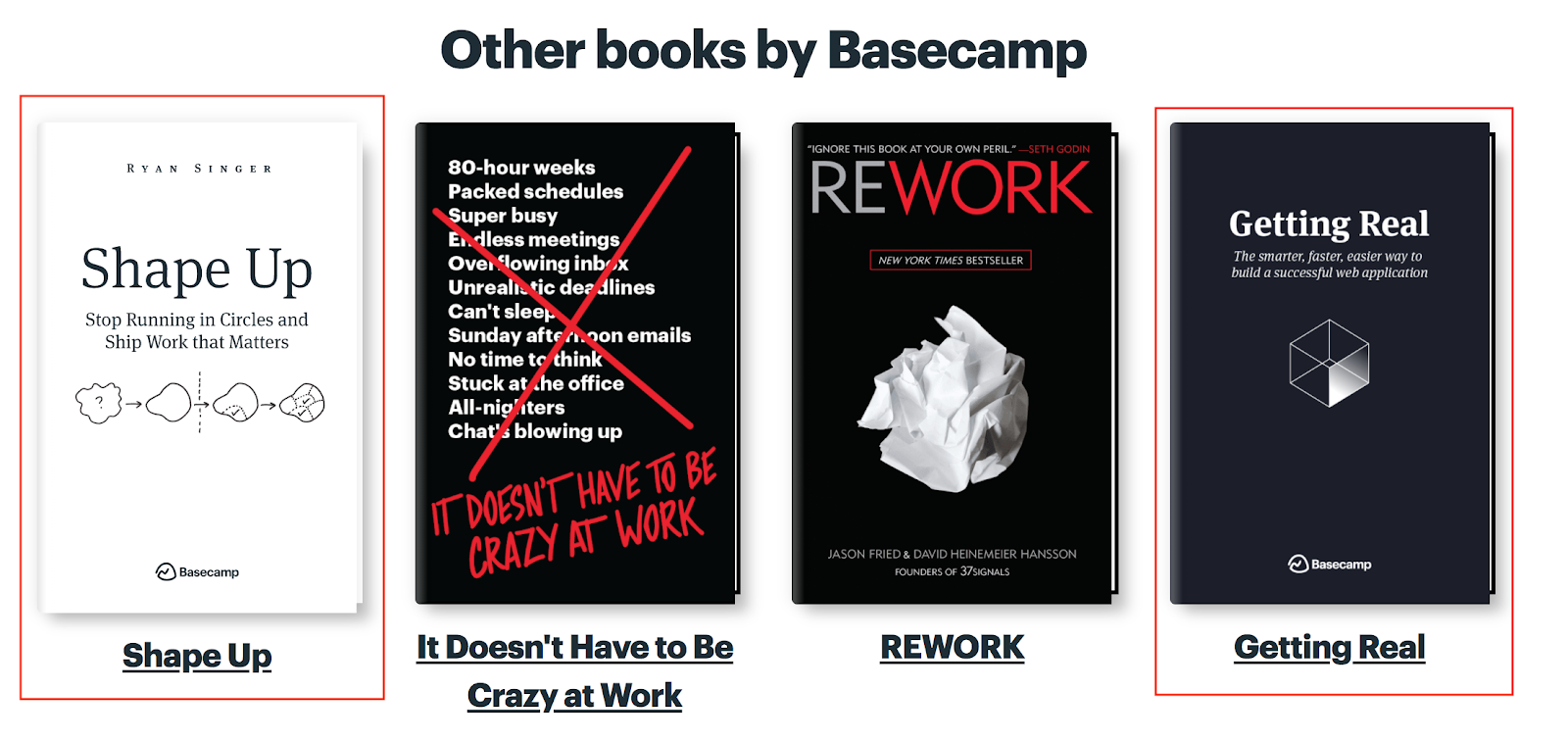
The books Getting Real and Shape Up are currently available for free to read online or as PDF versions.
Author’s Note: If you don’t know where to begin your brand journalism journey, literal storytelling is a great place to start. Be honest and personal about your brand story, whether it fills up a blog or a book.
Beyond the books, once you dive deeper into Basecamp’s website you will discover that they have a podcast called ‘The Rework Podcast’, where they share personal brand stories and unconventional wisdom on how to run a successful business for the future.
Sometimes the founders come on to speak but other times they get relevant people in the industry or even in the company to share their knowledge and stories.
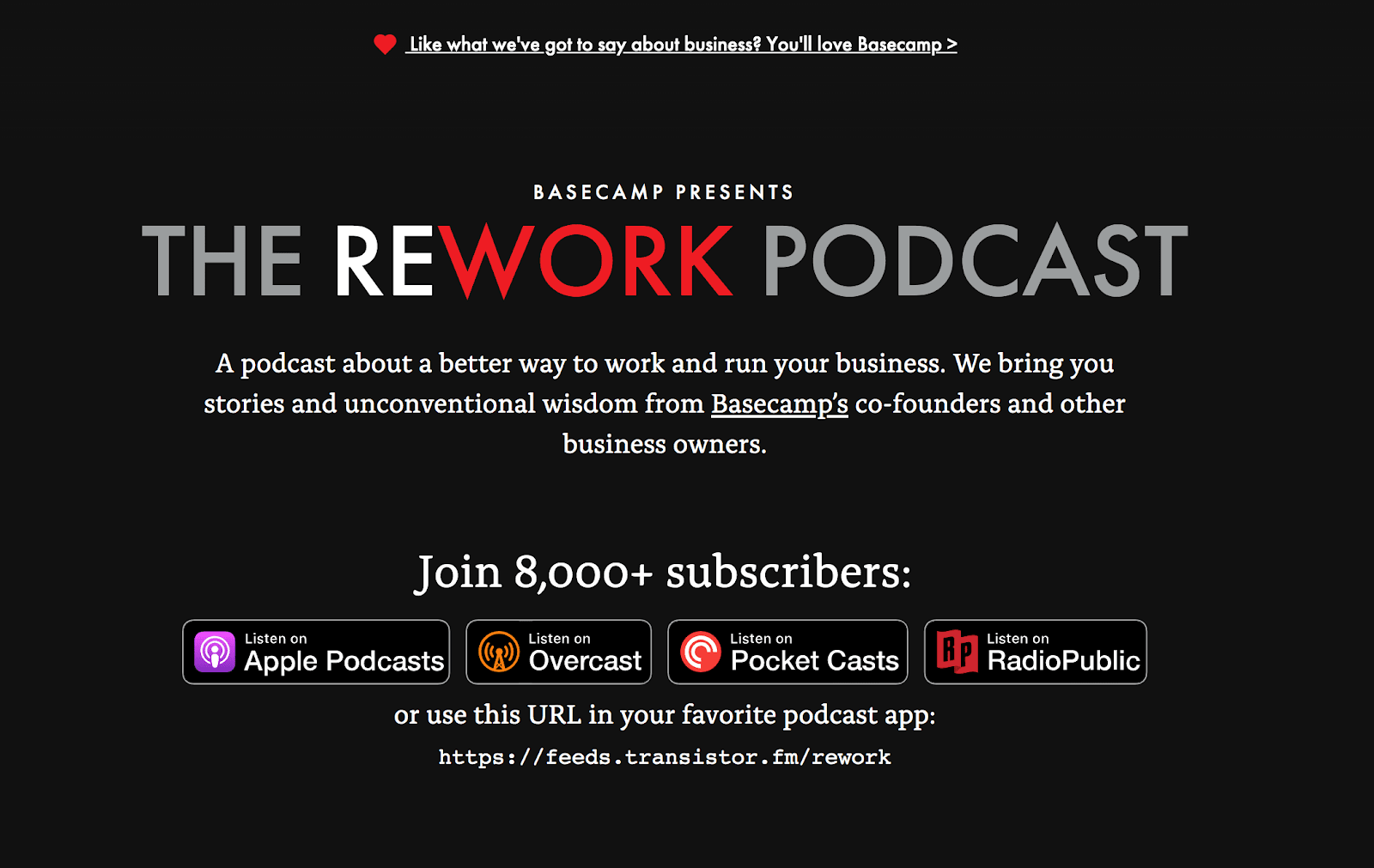
For example, their podcast entitled “Winston Sat At His Computer” has Basecamp’s CTO David Heinemeier Hansson explaining why surveillance systems don’t have a place in the modern workforce.
They want to make a connection with their listeners and provide great content that is relevant to their everyday lives, not just useless information.
They push beyond having high quality content to build a reputation but instead to build a community.
Example #5: KlientBoost
Now for the last brand on our list. KlientBoost is a PPC/CRO marketing agency that provides assistance for many eCommerce and SaaS companies.
Part of their marketing strategy is their blog, where you will find brand content that includes in-depth tips and strategy on improving the performance of your Google Ads, Facebook Ads and ultimately your conversion rates.
Another part is their YouTube Channel where you will find videos of their journey growing their MRR.
These videos are great because they are not super serious and boring like some informative videos can be. These are quirky and fun while still providing valuable insights.
One of our favorite things about KlientBoost is their weekly podcast, BoostSauce.
Founder and CEO Johnathan Dane is accompanied by experts in the industry as they share their opinion and viewpoint on how to be successful in the industry today.
One thing you’ll notice right away is that each podcast lists the number of nuggets dropped.
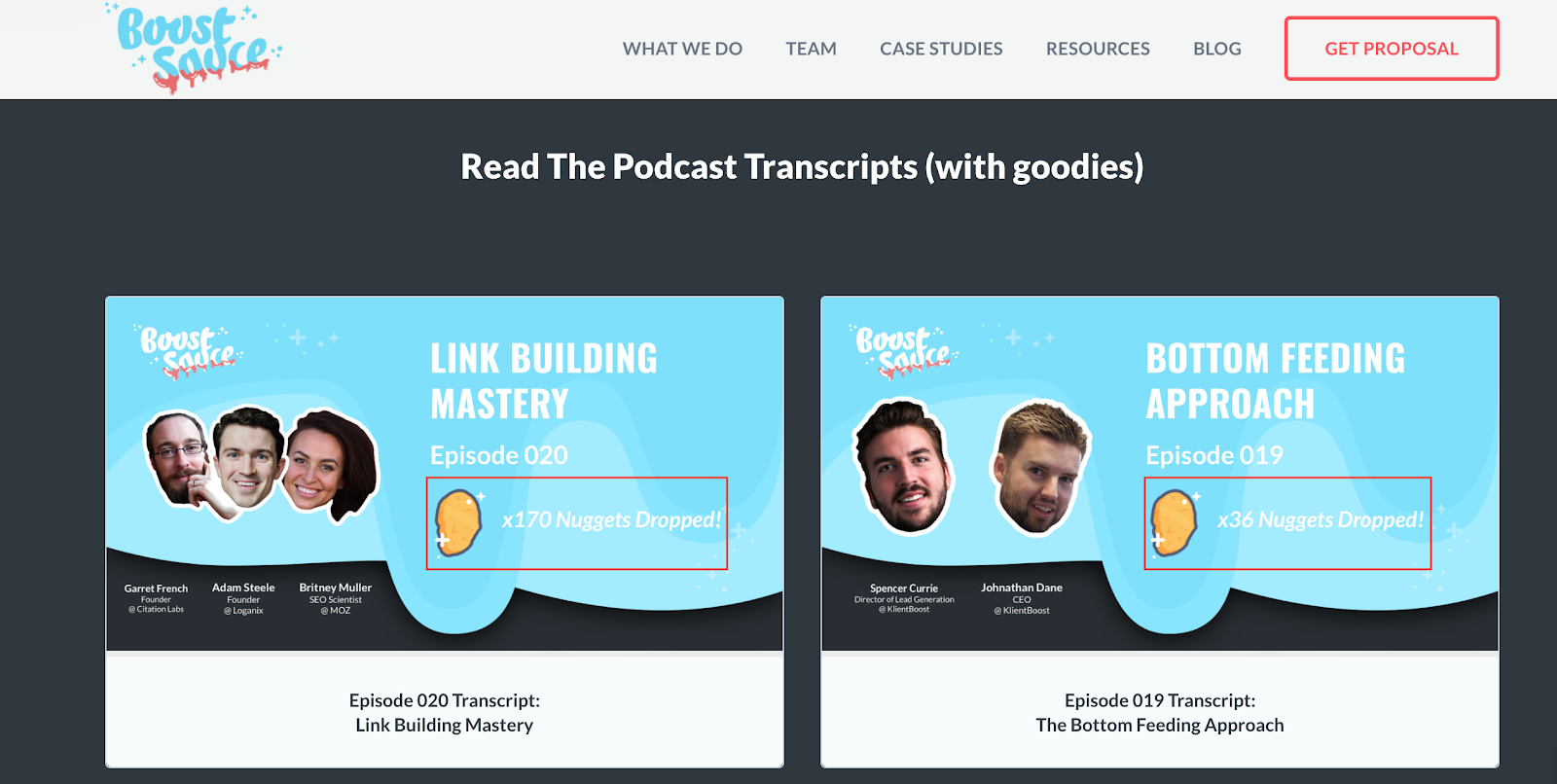
That symbolizes the “nuggets of wisdom” you will hear in the podcast. If you prefer to read through the podcast transcript, each nugget will be bolded, with a small nugget icon next to it.
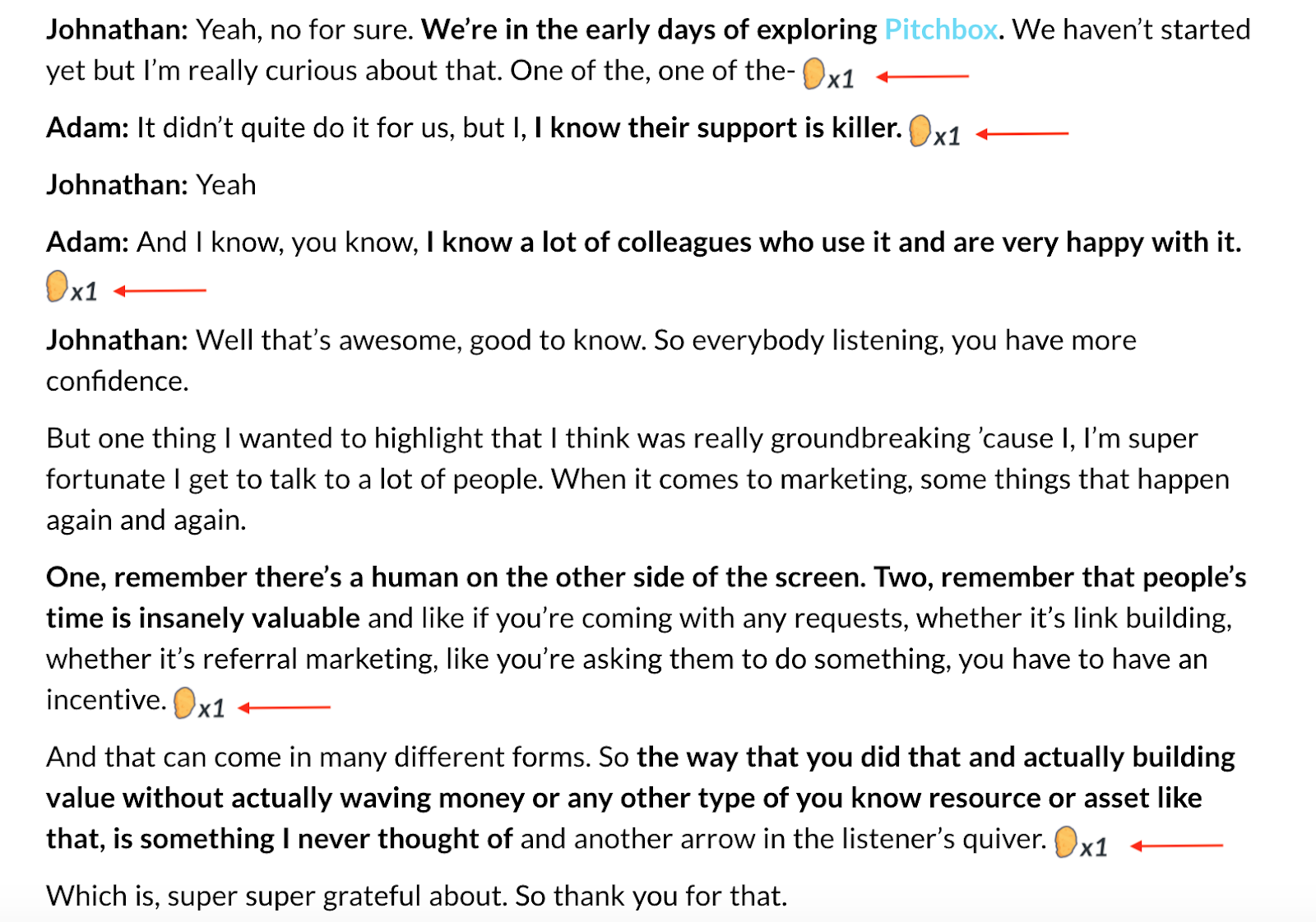
This is a fun way to highlight important information while showing your audience your brand style.
Whether you’re in SaaS, eCommerce, or lead gen, you’ll find that the information is not only beneficial and informative but also entertaining.
This is very different from traditional journalism because of the media type, the playful nature and the fact that it is more conversational but that’s what makes it great brand journalism.
It gives the brand familiarity, humor and builds that weekly relationship with their audience.
And with that, we’ve finished with all five examples of great brand journalism.
Let’s wrap this up and close with some final thoughts.
Link building cheat sheet
Wrapping Up
So, there you have it.
You now know what brand journalism is and why it matters for your business.
Do you have a brand story that needs to be heard? Do you want to share your journey with your audience? Do you have failures and wins that could help other people?
Then go on and create high-quality content around all these stories and learnings.
This will help you connect with your audience in a profound way.
It will also help you raise brand awareness and reach new audiences.
The best (and most interesting) part?
You don’t need a PR firm to create and distribute brand journalism content that makes an impact.
You can do it yourself – start your 14-day free trial to see how we can help.
Good luck!
Author’s Note: If you are needing PR help, check out the public relations part of our blog for more information.
